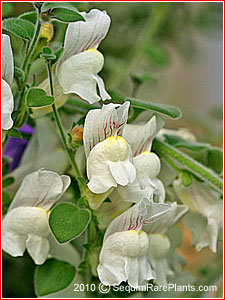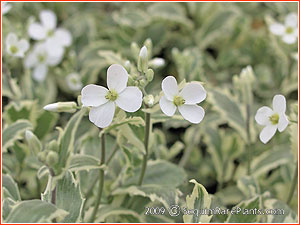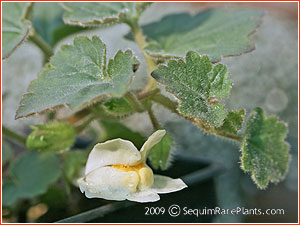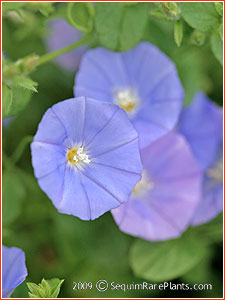This is an archive page. It is no longer active.
.png)
.jpg)
Allium sikkimense
This low growing (6 inches) ornamental onion has sky blue flowers in summer. With its narrow leaves and low height, it is suitable for a rock garden or planted with other low growing flowers at the front edge of a bed. Once established, it is undemanding. It is also known as Allium kansuense. USDA zones 6 - 8 in the East, zones 6 - 9 in the West.jpg)
Alyssum oxycarpum
Low growing and spreading, the tiny gray leaves of this perennial alyssum last through winter. In spring, bright clusters of yellow flowers appear en masse. Native to Turkey and the Balkans. USDA zone 4.
Antirrhinum glutinosum 'Gummy'
This low, moderately spreading perennial has gray leaves covered in hairs and sticky stems that spreads eight to fourteen inches wide and grows four to eight inches tall. Not a plant for northern rock gardens, this is best in milder parts of the U.S., such as parts of California and the West Coast. It will flow over the edge of a slope, charmingly. As a native of Spain it can take severe heat, and will flower from the beginning of summer until frost. Flowers of light yellow to creamy white, are one-inch long. USDA zones 8 to 11.
Arabis alpina subsp. caucasica 'Variegata'
Popularly known as rock cress, this unusual form has grayish-green leaves edged in cream that are evergreen, and can light up a garden year around. White, four-petaled half-inch wide flowers appear from early spring until the weather starts warming up, on elongating racemes that extend above and cover the foliage. A mature plant will reach eight to twelve inches tall when flowering, however otherwise will form a low mat of spreading growth with a height of six inches. It needs only average soil. The soil having good drainage is particularly important. For areas that have hot summers and high humidity, in areas south of Zone 7, it can be short lived. Doubly colorful with its flowers and foliage, Arabis is a good selection for a rockery, as an edging plant, and planted in the crevices of a rock wall. Native to mountains in Europe, it can survive winter cold to USDA zone 3.
Asarina procumbens
This is a relative of snapdragons from the mountains of the Pyrenees between Spain and France. This grows well in the garden where you will find it seeding itself about. So even though it isn't extremely winter hardy north of USDA zone 7, it can return year after year. With spreading, trailing growth, it likes filtered light as well as full sun, and flowers nonstop through summer. The round green leaves are lightly hairy. The flowers are 1½-inches long. A superb plant for crawling along crevices and over rocks, or trailing over the lip of a rock wall. USDA zones 7 - 11..jpg)
Asperula gussonei
A low cushion of fuzzy, needle-like leaves that are green during the growing season and turn brownish while dormant in winter. In late spring clusters of white flowers open from pink buds. Needs well-drained soil, particularly in winter. USDA zone 5. Plants that we send in early spring will have their brownish, winter foliage. Commonly known as alpine woodruff..jpg)
Aster alpinus 'Pinkie'
'Pinkie' is a low growing plant that is notable for its flowering in late spring, rather than in fall as is usual for most asters. This is a selected color form with larger bright pink flowers with golden eyes. We propagate it vegetatively so the flowers will be uniform in color. Because its parents are native to mountains in Europe, it is better suited for growing in cooler climates rather than where summers are warmer. It is especially suited for a rock garden, or planted towards the front of a flower bed. USDA hardiness zones 4 - 7 in the East, zones 4 - 8 in the West. And even farther north to zone 3 with snow cover or other protection..jpg)
Calceolaria 'John Innes'
Known as slipperflower, this is a hybrid of species, possibly of C. plantaginea and C. polyrrhiza, that are native to colder, very southern parts of South America. It can take winter cold to USDA zone 5 (-10 to -20°F). Its name comes from the John Innes Horticultural Institute, of Surrey, England, where it originated. The plant is low at six inches and spreads slowly wider in a compact mass. The flowers are large in size, the size of a U.S. nickel, although not round but longer, top to bottom. Each flower has its own four to nine-inch stem. Color of the flower is mainly a bright yellow, with a few reddish-brown spots on the pouch. It likes both good drainage, at the same time as not liking to fully dry out, in other words, ground that is moisture-retentive and quickly draining. If allowed to dry out too much in summer it will go dormant early. However just because it disappears above ground, don't think that it has died. A tip: choose a location such as a slope in full sun that is well drained, and mix in a generous amount of humus or compost to keep the roots moist..jpg)
Campanula 'Blue Waterfall'
(PP# 13,161) Mat-forming growth to eight inches tall that cascades attractively over the edge of precipices. When trailing down a wall or over the edge of a hanging basket, its violet-blue flowers (lighter in the center) have a lovely effect. With a season from early to late summer. 'Blue Waterfall' will reach a foot wide during its first year and by its second year reach two feet across. Lightly shearing it as new growth appears in early spring is recommended. USDA zones 4 - 7 (and Zones 8 and 9 in the West)..jpg)
Campanula x haylodgensis 'Blue Wonder'
Double violet flowers bloom in summer on this low bellflower that is a cross between two species, C. cochlearifolia and C. carpatica. Its flowers are about twice the size of Campanula 'Elizabeth Oliver's' blossoms. And they show well, facing upwards and outwards. Small in stature, growing about 4 inches tall, and very cold hardy, to -20°F..jpg)
Campanula cochlearifolia 'Elizabeth Oliver'
The double flowers of this elfin plant are small and a very light blue in color. Popularly called fairies thimbles, they show for many weeks in late spring in warmer climates, and in summer to fall in northern gardens. The plant's height is four inches, and it spreads modestly without over-crowding its neighbors. It is quite cold hardy, surviving winters where temperatures may drop to minus 20°F, or to minus 40°F if there is snow cover. Campanula 'Elizabeth Oliver' was named for the daughter of a Mr. Bull, of Nottingham, England in the 1970's. The recommended way to propagate it is by dividing in spring or early summer..jpg)
Campanula pulla
In early sumer, dangling purple bells come on low stems to 4 inches high, spreading into a mat of gorgeous bloom. Great when grown among paving stones or in a rockery. Sun loving. A native to the Austrian Alp, this is cold hardy to USDA zone 5, and zones 3 and 4 with snow cover..jpg)
Campanula scheuchzeri
(pronounced 'skook-zer-i) This species of bellflower has purplish-blue blossoms, growing as a low clump of leaves with flower stems of six to ten inches. It is a good size for a rock garden or towards the front of a garden bed. Spreading vigorously wider with new shoots coming from underground, it is not particular about its soil, although it would like to be kept moist through summer. Grows well in partial shade to full sun. USDA Zone 4 - 7, and Zones 8 and 9 in the West. The Latin name of the species honors the Swiss botanist, Johann Jakob Scheuchzer (1672 - 1733)..jpg)
Carex firma 'Variegata'
A choice miniature sedge ideal for a trough. It has dark green foliage with a wide, creamy-yellow edge and is a very eye catching plant. Because it is evergreen, it looks good year round. Height of 3 inches. From the Alps, and winter hardy to USDA zone 4.
Convolvulus mauritanicus
(also known as C. sabiatus) Not a rampant grower as are some of its weedy cousins, this is low and spreading, but never too fast. The lavender flowers appear in waves all summer on older plants. At night the flowers spiral-up to close, like little blue umbrellas. Prefers sun but will take light shade. Cascading and trailing growth that spreads to two or three feet. Has survived to 0°F (USDA Zone 7a or 6b). It is a spectacular ground cover for a sunny site, or added to a container garden for the summer outdoors. Several planted in a group make an extraordinary edging..jpg)
Dracocephalum ruyschiana var. argunense
Known as dragonhead, this six to twelve-inch tall perennial is long-flowering and undemanding. Light true-blue flowers appear from June to August. Ideal places to plant it would be in a rock garden or spilling over the lip of a rock wall, at the front of a flower garden, and as a perennial addition to a container garden. It has richly green narrow leaves. Cold hardy to USDA Zone 5, or Zone 4 with winter protection. It comes from Korea and neighboring areas of Russia..jpg)
Erodium absinthoides
Beautifully light pink flowers in clusters decorate the finely textured leaves of grayish green. Once established in a garden this plant is drought resistant. USDA Zones 6 - 9. Six to eight inches tall, and twelve inches wide. As a side note, the sexes occur separately -- the plants we offer are all females. Native to parts of southeastern Europe and Sicily..jpg)
Erodium cheilanthifolium
Creamy flowers have a delicate tracery of darker veins and two rich purplish blazes on the upper two petals. Long flowering and undemanding, this is a long lived perennial. Do not crowd it too closely with taller perennials, but allow it enough room to get lots of air and sunlight. It needs well drained soil to be long lived. Hardy in USDA Zones 6 - 9..jpg)
Erodium x kolbianum 'Natasha'
Small in scale, this plant has lacey, feathery gray leaves and pale pink flowers with purple veins and purple blotches on the upper two petals. Its height is two or three inches, with the flowers another two or three inches above. Grows easily in the sunny, open garden. Quickly draining soil is best for its longterm survival over winter. Hardy to USDA zone 5..jpg)
Eryngium variifolium
This seaholly has glossy green leaves with white veins. The flowerheads are more gray than blue, small at about the size of green peas and come on short stems of twelve to eighteen inches tall. What is more striking about the flowers are the very large, pointed spines surrounding the base of the flowers. They are colored silvery gray. Their attractive leaves are evergreen. A plant will grow into a slowly widening clump over several years. It develops a thick taproot and so is quite drought tolerant. Hardy in USDA zones 5 - 9..jpg)
Globularia cordifolia
This plant is a creeper that has leathery, evergren leaves, and blooms in late spring with powder puffs of very light lilac-blue. It grows as a spreading mat, the low stems often rooting as they grow wider. Its height is two to three inches with slightly taller flowers. Grows well in full to part sun. It needs a gritty, well drained soil. A native to the Mediterranean basin. Hardy to minus 20°F..jpg)
Gypsophila cerastioides
From late spring to early summer this alpine baby's-breath has masses of small white flowers that are beautifully striped in pink. Its small oval leaves are lightly hairy. It is easy to grow in a well-drained sunny site, with growth that is small enough for a trough or the front of a rock garden. In rich soil it tends to grow open and floppy, so plant in soil that isn't overly rich. For the best tight and compact growth, give it soil that is gritty and well drained. Grows 2 inches tall, spreading wider, to eight or ten inches. USDA zones 5 - 8. Native to the Himalayas..jpg)
Herniaria glabra 'Sea Foam'
This evergreen groundcover is a recent introduction and not yet widely grown. At first glance it looks to be a variegated thyme, with its tiny green leaves edged in cream and low, creeping habit. But it is more adaptable than thyme, growing in full sun or partial shade, and growing farther south. A very undemanding plant, its rate of spread is not too fast. And because it is so low, it is an excellent choice for a groundcover in a variety of situations and adaptable to many locations. Because Herniaria 'Sea Foam' can withstand a moderate amount of being walked upon, it does well planted among flagstones on a terrace or between paving stones in a walkway. Although not good for heavy shade, it does well in partial shade, making a good groundcover under taller plants when the light is partial sun and partial shade. Hardy as far north as USDA zone 4b, it also grows well in the South..jpg)
Iris sauveolens var. rubromarginata
The leaves are arching and extremely low. The flowers reach a bit higher, to four or five inches. The flowering season is March and April, although it often reblooms lightly during summer and fall. The flowers are large for the small size of the plant. The flowers are a brownish maroon, with prominent white beards. It is native to northwestern Turkey northwards into the Balkans. Cold hardy to minus 30°F. It grows well in both half a day of sun or in full sun. Soil should be well drained. The 'Rubromarginata' in its name refers to a faint, fine line of red along the leaf edges..jpg)
Jovibarba heuffelii 'Irene'
This succulent hen-and-chicks has leaves that are mostly a rich, medium red, being a lighter red closer to the center of the plant and a darker red towards the leaf tips. The leaf edges standout with a lighter coloring, due to the small hairs lining the edges. Cold hardy -20° to -30°F (USDA zone 4)A few more Jovibarbas can be found on another page of our website (click here).
.jpg)
Lewisia columbiana var. rupicola
Lewisias are among the royalty of rock garden plants. This lewisia is smaller in scale than many other lewisias, with tight clusters of evergreen leaves, 1 - 3 inches long and ¼-inch wide. Twelve-inch tall sprays of small, open-faced flowers show for weeks in spring and early summer, colored in white with magenta/purple edging and striping. This is a drought-tolerant succulent, with its thick, fleshy leaves storing moisture for times of drought. The plant is less likely to die for a lack of water than it would be to die from over-watering. When grown in the ground of a rockery or rock garden, little if any supplemental watering is needed other than what nature supplies. If grown in a container, it should be watered in summer, but allow the soil to dry out thoroughly between waterings. As with many succulents, it will have a thick, fleshy taproot. In the wild, during severe drought it will live on the moisture within its own leaves, and shrivel up to become next to nothing, but will revive as soon as fall rains return. USDA zones 4 - 8. Our plants are propagated by cuttings, so will have flowers matching the photo..jpg)
Nepeta nervosa 'Forncett Select'
Growing to a size of ten inches tall, this bushy perennial flowers from June through August, bringing welcome color to the late summer garden. Its flowers are a rich violet-blue. Hardy to USDA zones 5 - 9, this species is native to Kashmir. It likes well-drained soil in sun. Easy to grow and undemanding..jpg)
Parochetus communis
Known as both blue oxalis and shamrock pea, this is native to mountains in Africa and Asia. It is low at 1 to 3 inches tall and spreads widely to a couple of feet or more. The green leaves often have a circle pattern of dark red. The cobalt blue flowers are unbelievable at first sight. Flowers are produced for a long season. Plant it outdoors in the spring to give it a good start, and it will survive over winter to USDA zone 8b (15 to 20°F). It is a very vigorous plant that will resprout from its roots if the top of the plant is killed. Potting up a piece of the plant to keep indoors over winter might be a good precaution against the possibility of loosing it. Blue oxalis is content to live planted in a pot year around. In a greenhouse it may well flower all winter. It adds nicely to a hanging basket or deck planter..jpg)
Phlox glaberrima 'Triple Play'
The leaves are green and cream, tinged in pink during fall and winter. A low and spreading plant, the lavender-pink flowers are taller at 4 to 8 inches and bloom heavily in late spring with a second bloom at the end of summer. And they are favorites of hummingbirds and butteflies. Cold hardy from USDA zone 4 to 8, Phlox glaberrima is native from Wisconsin south to Florida. If several are planted as a group, space them about 8 to 10 inches apart. (Plant patent 21,329).jpg)
Phlox subulata 'Candy Stripe'
Pink and white striped flowers cover this low growing plant in mid to late spring. The foliage is low and spreading, forming a carpet of green, with a height of 6 inches or less. Evergreen leaves. Butterflies love these flowers..jpg)
Phyteuma scheuchzeri
Not frequently offered at nurseries, the common name of this is horned rampion. It is a close relative of bellflowers, Campanula, although the flowers are quite different in appearance from bellflowers. Each flowerstem holds a ball-shaped cluster of violet-blue flowers, and long, spiky bracts, that have a light, dainty character. Its foliage is thin and grass-like. Horned rampion hails from the mountainous Alps of Europe. Hardy to USDA zones 6 to 9, and to Zone 5 with protection. Its flowering season is early to mid summer, and blooms at a height of eight to ten inches..jpg)
Ruschia pulvinaris
Closely related to iceplants, Ruschia comes from high elevations in South Africa and is said to survive outdoors where winter temperatures drop to minus 10°F. Discovering how much cold it can take, it is becoming increasingly popular in American gardens. To survive a cold winter, it needs to be well established, and as such, should be planted in early summer rather than towards summer's end. The foliage is a tight mass of evergreen leaves. The shocking pink flowers bloom for several weeks in late spring. It grows about three inches tall and expands to a foot wide or more. Our plants are propagated by cuttings so the flower color will match the color in our photo. As it loves heat, it is a good choice for especially hot locations..jpg)
Saxifraga x fritschiana
This is a natural hybrid that is native to the Alps, forming mats of tiny very silver foliage with creamy white blooms on 6-inch scapes. It does especially well in full sun. The species that are its parents are Saxifraga paniculata and S. crustata..jpg)
Saxifraga paniculata 'Lutea'
The gray-green rosettes of leaves have lightly serrated, lime encrusted edges. In late spring and early summer, creamy pale-yellow flowers arise on stems of six to ten inches. Its name of “lutea” refers to the yellow coloring of the flowers, however the color is quite light, closer to white than to yellow. This evergreen is not difficult to grow when given well drained soil and a location in bright light, although growing none too fast. A popular name for this is rockfoil. It does well with a meager amount of soil, such as in the crevices between rocks or in stone rubble. Also, in a pot garden with other drought tolerant succulents. Cold hardy to minus 30°F..jpg)
Saxifraga paniculata ssp. petrophila
Tight growth and small evergreen leaves define this creeping perennial. The leathery leaves are toothed with distinctive lime-encrusted pores on each leaf. Its native habitat is arctic and alpine regions, so it survives well to -30°F. In gardens, shading it from the hot afternoon sun is advised, at least where summers are especially warm. It is a choice plant for planting in the crevices between rocks, where it will creep along the crevices from rock to rock. The scale of this plant is very small. Dainty, creamy flowers come in May/June on stems of six to eight inches tall..jpg)
Sempervivum arachnoideum 'Rubrum'
A selection of the species, arachnoideum, the tightly held leaves form a rounded plant that is overlaid with a fine network of cobwebbing that is typical of this species. The leaves are green that are often, but not always strongly colored in red. Cold hardy to USDA zone 3 (-30° to -40°F). As is true for many frost-hardy succulents, applies equally to this hen-and-chicks, that illustrating it with a single photo is not completely accurate, because the colors change throughout the year. And sometimes the color change is dramatic. Not only do the colors change according to the season, but also according to how much sun or shade it receives.Many more Sempervivums can be found on another page of our website (click here).
.jpg)
Solidago virgaurea subsp. alpestris
(syn. S. vigaurea subsp. alpestris var. minutissima) This miniature goldenrod has low growing, ground-hugging foliage of dark green leaves. In late summer and early fall, tiny golden daisy-like blossoms appear on short, 2 to 4-inch stems. Give it full sun and a well drained soil. As it blooms in late summer, watering it then may be necessary in a dry year, to get the best show of flowers. A native to the high mountains of Japan's southernmost island, Kyushu. Attracts bees and butterflies. Hardy to USDA zone 4 (-20°F to -30°F)..jpg)
Succisa praetensis (dwarf form)
We received this from Mt. Tahoma Nursery, and to quote that nursery's description, this is “a cute little summer blooming rock garden plant from the Caucasus. Mats of dark green, lanceolate leaves with rich violet-purple pincushion flowers held on short stems. Easy to please.” Height of 5 inches. USDA zones 5 - 9..jpg)